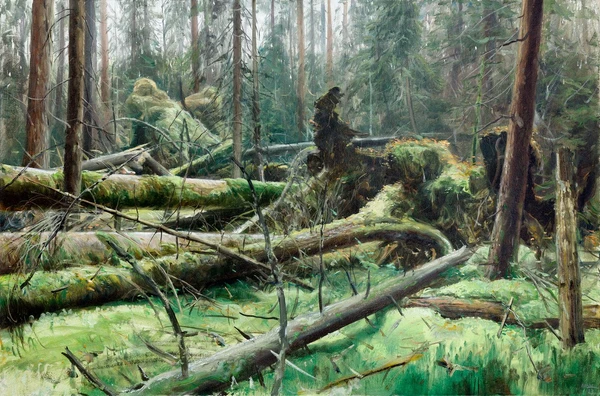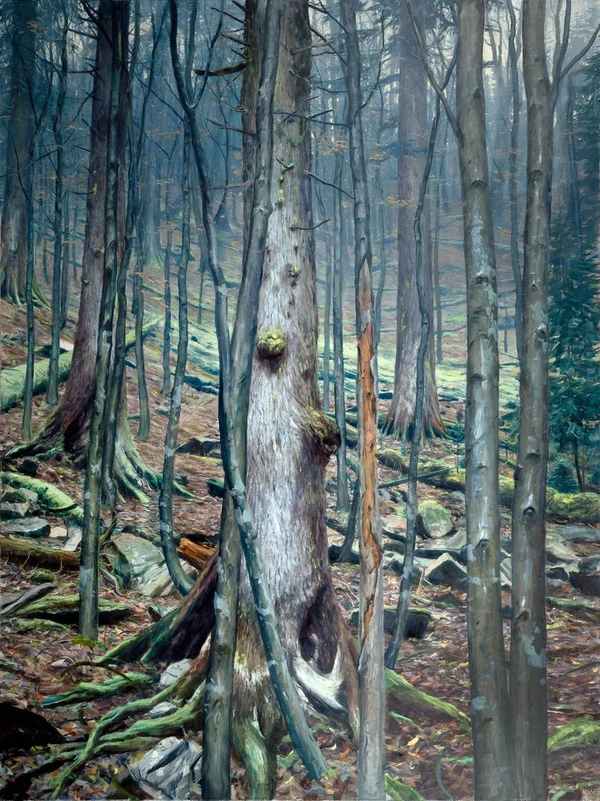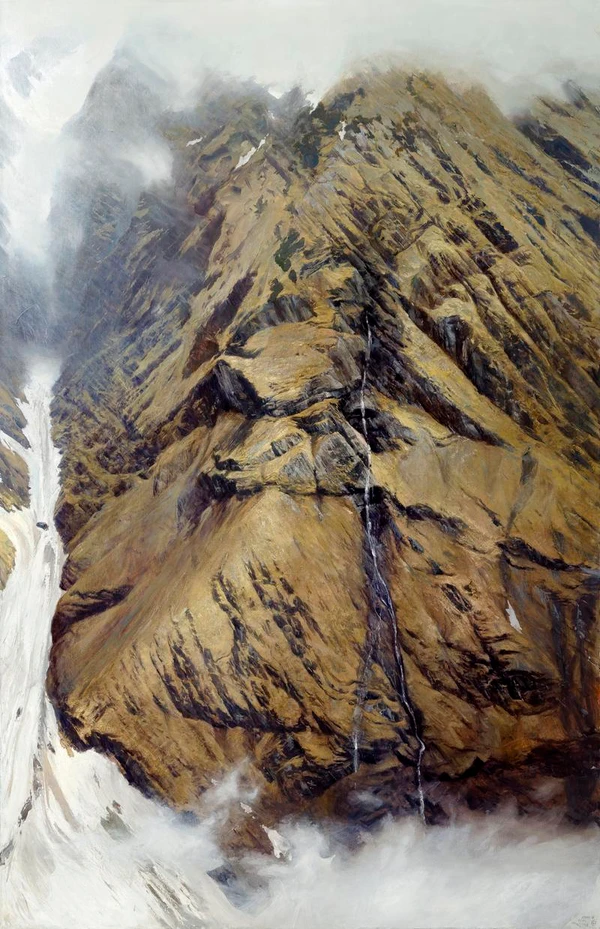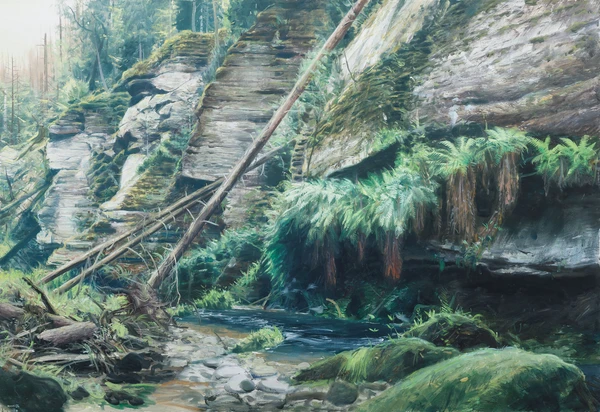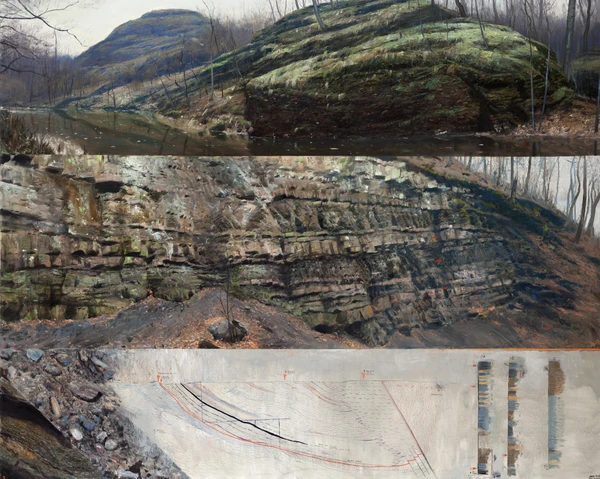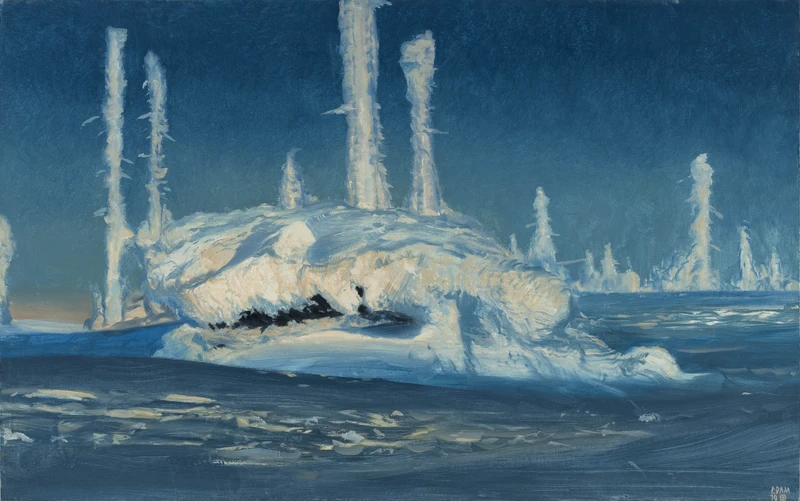
Adam Kašpar
Adam Kašpar (1993) je jednou z nejvýraznějších osobností současné české realistické malby. Pro svůj velký talent zachytit atmosféru netknuté přírody hlubokých lesů a pralesů bývá často spojován s nestory české krajinomalby, a zejména pak se jménem Julia Mařáka.
Interiér lesa však není jediným umělcovým tématem. Ve své tvorbě se zabývá pradávným vznikem přírody a stejně tak i jejím zánikem. Život krajiny ho fascinuje jako komplexní fenomén a zajímá se nejen o existenci rostlin, ale i o bytí „neživých“, anorganických přírodních materiálů, jakými jsou skály, kameny, nebo třeba v nejnovějším cyklu vesmírné objekty. Již za svých studií na pražské Akademii zaujal řadu sběratelů a kurátorů, a to nejen kvůli svému neutuchajícímu zájmu o krajinu, který jej vedl od hlubokých pralesů přes mongolské pustiny až po islandské ledovce, ale zejména pro svůj konceptuální, až vědecký postup práce. Při své tvorbě se neobejde nejen bez malířského a kreslířského náčiní, ale ani soudobé techniky fungující jako extenze lidského oka: například fotoaparátu, dalekohledu k pozorování dalekých vesmírných těles nebo mikroskopu ke zkoumání hornin. Nahlédneme-li do malířových skicářů, hemží se to v nich poznámkami o sedimentaci hornin, výpisky z geologických skript, mapami, představami, jak krajina vypadala před zásahem lidské ruky, nebo třeba i vlastními prožitky z bytí v přírodě. Na rozdíl od romantických krajinomaleb 19. století u Kašpara spatřujeme až archeologický výzkum života planety Země a jeho plenérové malby jsou často spíš průzkumem archivu přírody než snahou o zachycení konkrétní jednotlivosti. Ve výběru Kašparových témat silně rezonuje krajina vyhýbající se jakémukoliv náznaku lidské existence. V současné době klimatické krize by bylo možné o tomto fenoménu uvažovat jako o idylické snaze navrátit se zpět před vznik civilizace. Ponoří-li se však člověk hlouběji do Kašparovy tvorby, nalezne i malby Severočeské pánve či jiná místa hluboce dotčená lidskou existencí, ač tak třeba na první pohled nevypadají. Spíše než jako pre-humanistickou bychom tak měli umělcovu tvorbu vnímat jako post-humanistickou a chápající, a tak i akcentující věk antropocénu jakožto filosofického fenoménu (geochronologicky ještě nelze zcela jistě potvrdit). Ač bývá označován za realistického malíře, často maluje realitě navzdory a krajinu skládá z více různých úhlů pohledu, aby akcentoval určitý geopolitický problém, či ji přetvoří do podoby, jak by vypadala bez zásahu lidské ruky, nebo spíše naopak za několik desítek či set let po přirozené asanaci lidského zásahu. Jeho díla jsou zastoupena jak ve významných českých, tak i zahraničních sbírkách současného umění a navštívila řadu velmi zajímavých a důležitých výstav. Mezi jinými například i výstavu Světlo v obraze: český impresionismus, uspořádanou roku 2017 v Jízdárně Pražského hradu, kde visela po boku takových autorů, jakými jsou například Antonín Slavíček, Max Švabinský, ale i Eugène-Louis Boudin nebo Claude Monet.
Vybrané výstavy:
- Universum, Galerie Ludvíka Kuby Poděbrady, Poděbrady, CZE, 2021
- Klenbou – Brázdou, Galerie Josefa Jambora, Tišnov, CZE, 2019
- Mapa hor, Nová galerie, Praha, CZE, 2018
- Earth, Basel Art Centre, Basilej, CHE, 2018
- Jen prostor, Galerie města Pardubic, Pardubice, CZE, 2018
- Světlo v obraze: český impresionismus (kolektivní výstava), Jízdárna Pražského hradu, Praha, CZE, 2017
- Fascinace skutečností | Hyperrealismus v české malbě (kolektivní výstava), Muzeum umění Olomouc, Olomouc, CZE, 2017
Interiér lesa však není jediným umělcovým tématem. Ve své tvorbě se zabývá pradávným vznikem přírody a stejně tak i jejím zánikem. Život krajiny ho fascinuje jako komplexní fenomén a zajímá se nejen o existenci rostlin, ale i o bytí „neživých“, anorganických přírodních materiálů, jakými jsou skály, kameny, nebo třeba v nejnovějším cyklu vesmírné objekty. Již za svých studií na pražské Akademii zaujal řadu sběratelů a kurátorů, a to nejen kvůli svému neutuchajícímu zájmu o krajinu, který jej vedl od hlubokých pralesů přes mongolské pustiny až po islandské ledovce, ale zejména pro svůj konceptuální, až vědecký postup práce. Při své tvorbě se neobejde nejen bez malířského a kreslířského náčiní, ale ani soudobé techniky fungující jako extenze lidského oka: například fotoaparátu, dalekohledu k pozorování dalekých vesmírných těles nebo mikroskopu ke zkoumání hornin. Nahlédneme-li do malířových skicářů, hemží se to v nich poznámkami o sedimentaci hornin, výpisky z geologických skript, mapami, představami, jak krajina vypadala před zásahem lidské ruky, nebo třeba i vlastními prožitky z bytí v přírodě. Na rozdíl od romantických krajinomaleb 19. století u Kašpara spatřujeme až archeologický výzkum života planety Země a jeho plenérové malby jsou často spíš průzkumem archivu přírody než snahou o zachycení konkrétní jednotlivosti. Ve výběru Kašparových témat silně rezonuje krajina vyhýbající se jakémukoliv náznaku lidské existence. V současné době klimatické krize by bylo možné o tomto fenoménu uvažovat jako o idylické snaze navrátit se zpět před vznik civilizace. Ponoří-li se však člověk hlouběji do Kašparovy tvorby, nalezne i malby Severočeské pánve či jiná místa hluboce dotčená lidskou existencí, ač tak třeba na první pohled nevypadají. Spíše než jako pre-humanistickou bychom tak měli umělcovu tvorbu vnímat jako post-humanistickou a chápající, a tak i akcentující věk antropocénu jakožto filosofického fenoménu (geochronologicky ještě nelze zcela jistě potvrdit). Ač bývá označován za realistického malíře, často maluje realitě navzdory a krajinu skládá z více různých úhlů pohledu, aby akcentoval určitý geopolitický problém, či ji přetvoří do podoby, jak by vypadala bez zásahu lidské ruky, nebo spíše naopak za několik desítek či set let po přirozené asanaci lidského zásahu. Jeho díla jsou zastoupena jak ve významných českých, tak i zahraničních sbírkách současného umění a navštívila řadu velmi zajímavých a důležitých výstav. Mezi jinými například i výstavu Světlo v obraze: český impresionismus, uspořádanou roku 2017 v Jízdárně Pražského hradu, kde visela po boku takových autorů, jakými jsou například Antonín Slavíček, Max Švabinský, ale i Eugène-Louis Boudin nebo Claude Monet.
Vybrané výstavy:
- Universum, Galerie Ludvíka Kuby Poděbrady, Poděbrady, CZE, 2021
- Klenbou – Brázdou, Galerie Josefa Jambora, Tišnov, CZE, 2019
- Mapa hor, Nová galerie, Praha, CZE, 2018
- Earth, Basel Art Centre, Basilej, CHE, 2018
- Jen prostor, Galerie města Pardubic, Pardubice, CZE, 2018
- Světlo v obraze: český impresionismus (kolektivní výstava), Jízdárna Pražského hradu, Praha, CZE, 2017
- Fascinace skutečností | Hyperrealismus v české malbě (kolektivní výstava), Muzeum umění Olomouc, Olomouc, CZE, 2017


